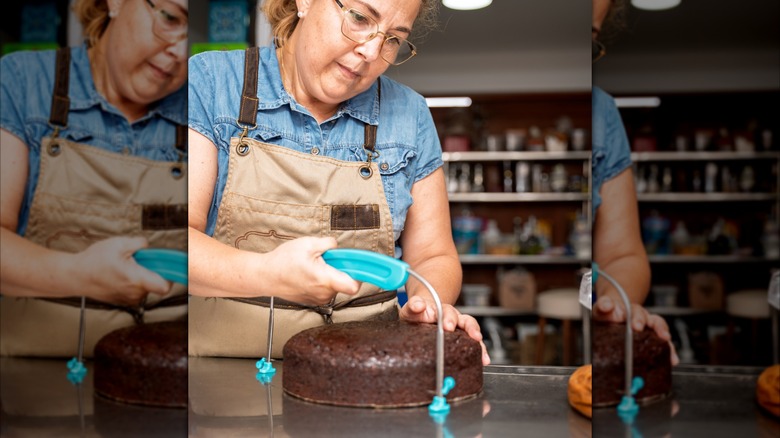The Forgotten Baking Tool That Gives You Even Cake Layers Every Time
It's no secret that professionally-made cakes are a work of art, towering over other pastries in the display case, perfectly level, covered in frosting that look hyper-realistic. Yet when you make cakes at home, your layers come out lumpy and uneven or crumble to pieces. This age-old crisis calls for an old-school solution, and Food Republic spoke to Odette D'Aniello, baking expert and CEO at Dragonfly Cakes, to learn more.
The secret to success is a classic cake leveler. "After more than two decades of stacking wedding cakes and multi-tier customs, we can confidently say: A cake leveler is great for a novice who's starting to bake more and more," D'Aniello said. Even if you've used the damp towel trick for even cake layers, a leveler helps adjust for any human error. As D'Aniello explained, "It gives you clean, even cuts every time — way more consistent than a serrated knife or trying to eyeball it."
There's less risk of smooshing the cake by accident when cutting it, and you avoid lopsided layers that may be more difficult to handle in the long run. According to D'Aniello, "Even layers mean your cake is stable and easier to decorate, especially if you're working with buttercream or fondant." So don't kill your cakes with overconfidence, especially if you're investing in making cakes long-term. Start with a leveler to build your skills on a strong foundation. That way, you can forget about sheet pan cake hacks and get your layers right on the first try.
More cake leveling tips
Just because you have a cake leveler doesn't mean you can just go hacking away at the layers the second they pop out of the oven. According to chef Odette D'Aniello, you should "trim the cake when it's slightly chilled. That helps minimize crumbs and makes the cut smoother." Working with a cooled or even refrigerated cake is also best for applying icing, so much so that it's on Ina Garten's list of cake tips — so don't get over-eager and work with your cake too quickly out of the oven. After all, there's a reason cakes are stored in the fridge to maintain their flavor and shape, so apply the same principles to the decorating process.
When it comes to actually cutting the layers, D'Aniello said to "use a gentle sawing motion and rotate the cake as needed to keep things even." The rotation will help you look at all sides of the cake so you can get a sense of the cut's depth around the whole cake. "And if you're trimming multiple layers, keep the leveler at the same height each time for symmetry," added D'Aniello. "It's a small step that makes your finished cake look professionally done, even at home." This is especially true if you are leaving the layers exposed, so the layers appear identical no matter which angle you're looking from. You'll have a beautiful, presentable cake, and nobody will complain about your layer ratios because their slice was lopsided.


